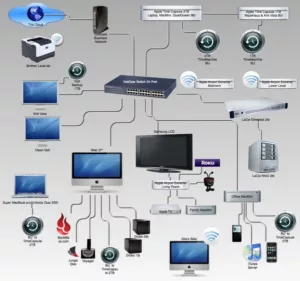Network Solution
Network Solution is the practice of protecting computer networks and their associated systems from unauthorized access, modification, or destruction. The goal of network security is to create a secure environment where users can safely access network resources and perform their work without fear of compromise.
Network security involves several components and practices, including:
- Access control: This is the process of limiting access to network resources based on user identity, role, and permissions.
- Firewalls: Firewalls are a crucial component of network security, as they act as a barrier between the internal network and the outside world. Firewalls can be configured to block certain types of traffic, filter out malicious content, and prevent unauthorized access.
- Encryption: Encryption is the process of converting data into a form that cannot be easily understood by unauthorized parties. Encryption is used to protect data in transit and data at rest.
- Intrusion Detection and Prevention: Intrusion detection and prevention systems (IDPS) are used to monitor network traffic for signs of suspicious activity. IDPS can detect and prevent unauthorized access, malware infections, and other security threats.
- Security Information and Event Management (SIEM): SIEM is a security management approach that involves collecting, analyzing, and correlating security data from multiple sources to identify and respond to security incidents.
- Patch management: Regularly updating software and firmware with the latest security patches is critical for protecting against known vulnerabilities and exploits.
In addition to these practices, network security also involves staying up-to-date with the latest security threats and trends, implementing security policies and procedures, and providing ongoing security training to employees. Contact us
What is the Network ?
A network is a group or system of interconnected things, such as people, computers, devices, or organizations. In the context of technology, a network typically refers to a collection of computers, servers, and other devices that are connected together to share information, resources, and services.
Computer networks can be classified according to their size and scope, such as local area networks (LANs) that cover a small area, wide area networks (WANs) that span larger geographic regions, and the internet which is a global network of networks.
Networks can also be classified based on their topology, or the physical and logical arrangement of the network components. Examples of network topologies include bus, ring, star, and mesh.
Network solution in Pakistan
A network solution is a comprehensive plan or strategy to address the networking needs of an organization or individual. It involves selecting the appropriate hardware, software, and protocols to establish a network that meets the requirements of the organization or individual.
A network solution typically involves the following steps:
- Requirements gathering: Identify the specific networking needs of the organization or individual, such as the number of users, types of applications, and traffic volume.
- Network design: Design the physical and logical layout of the network, including the types of devices, connections, and protocols to be used.
- Network hardware and software selection: Select the appropriate network hardware, such as routers, switches, and servers, and network software, such as operating systems, network management tools, and security software.
- Implementation and deployment: Configure and install the network hardware and software according to the network design.
- Testing and optimization: Test the network for performance, reliability, and security, and optimize the network configuration as needed.
- Maintenance and support: Provide ongoing maintenance and support to ensure the network continues to meet the needs of the organization or individual.
A well-designed and implemented network solution can provide many benefits, such as increased productivity, improved communication and collaboration, enhanced security, and reduced costs.
In addition to these practices, network security also involves staying up-to-date with the latest security threats and trends, implementing security policies and procedures, and providing ongoing security training to employees. Contact us
